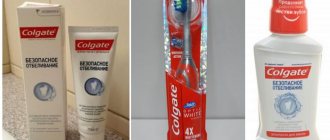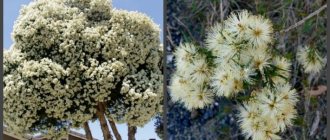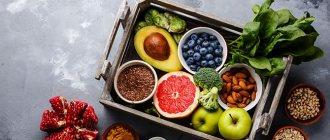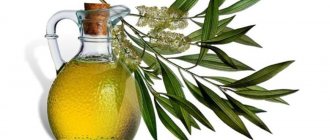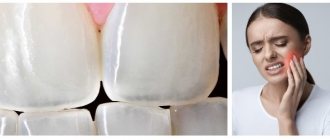Purpose
It should be noted that at that time the purpose of tooth powder was not to prevent caries or treat periodontitis. At that time they did not even know such words, did not understand the reasons for their occurrence, and therefore could not yet contain these diseases with hygienic means. The main and only goal was to cleanse the teeth of plaque and tartar. Please note: in the first half of the 20th century, dentists had not yet performed such a now widespread procedure as professional oral hygiene. Neither ultrasonic nor air-abrasive (Air-Flow) treatment had yet been invented. The only way to remove conspicuous plaque is to clean it yourself.
What is tooth powder
A hygienic product for the oral cavity, which consists of 98-99% of chemically deposited chalk (other bases are less commonly used). The rest consists of various additives, corrective properties and additional characteristics of the powder for teeth.
The ancient Romans used crushed bones, egg shells, shells and shells of sea creatures to make it. Their substance was used as a means for pain relief and teeth whitening.
The development of dental care continued relatively uneventfully until 1000 AD, when the Persians warned others of the dangers of using overly abrasive powders that could damage teeth. They proposed creating the powder using softer materials such as burnt snail shells, dried animal parts, herbs and honey.
The founder of the modern product originated in Great Britain at the end of the 18th century. Tooth powder was first introduced to the market in the UK.
These powders may have been developed by doctors, dentists and chemists, but they also included some quite abrasive substances: brick dust, ground porcelain, pottery and cuttlefish. Bicarbonate of soda, commonly known as baking soda, was often a key ingredient. By the end of the century, borax was added for cleansing and foaming purposes.
Starting line-up
Therefore, a good century-old tooth powder is one that has excellent abrasive properties. Hence they added to it: pumice, sand, ground bones, eggshells, mollusk shells, broken bricks and God knows what else. It must be said that toothpastes of those times were in no way behind powders in terms of abrasiveness. Moreover, to help a good cause, individual inventors added acids and alkalis of varying degrees of aggressiveness to them. Well, of course - after all, tartar softened by acid is easier to remove (alkali has not proven its worth in this regard). In general, the evolution of hygiene products has moved towards clearly expressed aggressiveness.
How to cook at home
In addition to factory-made powders, many craftsmen use self-made products. Their advantages are the naturalness and availability of the main ingredients.
To prepare the product you will need:
- White clay;
- sage leaves;
- thyme;
- Oak bark.
We have listed the names of vitamins for teeth and gums for adults, which are most often prescribed by dentists. In the next article we will tell you how effective Crest Whitestrips are.
At this address: https://dentist-pro.ru/krasota-i-uxod/preparaty-i-produkty/kak-ukrepit-v-domashnix-usloviyax.html - you can find information on how to strengthen your gums at home.
All components are thoroughly crushed using a blender, coffee grinder or a regular mortar. The main thing is that the composition is homogeneous and does not contain large particles . You can add a few drops of mint or eucalyptus oil to the finished mixture. The resulting product must be stored in a hermetically sealed container in a place protected from direct sunlight.
Some recipes for making powder recommend adding soda as a base. However, you should be careful with this substance: it has an aggressive effect on tooth enamel, so you should replace it with clay or carefully crushed salt.
This video describes a recipe for making herbal tooth powder:
Harm
But in 1907, an outstanding article was published in The Dental Cosmos: Miller WD. Experiments and observations of the wasting of tooth tissue variously designated as erosion, abrasion, chemical abrasion, denudation, etc. It had about the same impact on dentists as Albert Einstein’s “On the Electrodynamics of Moving Bodies,” published two years earlier, had on physicists. Equipped with terrifying illustrations, it clearly demonstrated the monstrous abrasion of teeth (in vitro) with pastes and powders. Here's one example:
Quality improvement
Of course, not all dentists read this study. Consumers of the powder certainly had no idea about it. Therefore, it took decades before highly abrasive components began to be abandoned. Such useful indicators as RDA (relative dentin abrasivity) and REA (relative enamel abrasivity) were introduced. The lower they are, the less the teeth wear out. Today, manufacturers who respect their customers indicate digital RDA values on each tube. Less than 70 – low abrasiveness, 71-100 – moderate, 101-150 – high, 151-200 – very high. Here is the RDA table for some modern pastes:
| Toothpaste name | RDA | Toothpaste name | RDA |
| Toothbrush with plain water | 4 | Colgate Sensitive Max Strength | 83 |
| Regular baking soda | 7 | Aquafresh Sensitive | 91 |
| Weleda Salt Toothpaste | 15 | Sensodyne Cool Gel | 92 |
| Elmex Sensitive Plus | 30 | Rembrandt Plus | 94 |
| Sensodyne ProNamel | 34 | Sensodyne Fresh Impact | 94 |
| Arm & Hammer Dental Care | 35 | Sensodyne Original | 100 |
| Weleda Calendula Toothpaste | 45 | Sensodyne Extra Whitening | 104 |
| Weleda Ratanhia Toothpaste | 45 | Sensodyne Full Protection Whitening | 107 |
| Arm & Hammer Dental Care Sensitive | 48 | Aquafresh Whitening | 113 |
| Tom's of Maine Children Toothpaste | 57 | Lacalut White | 120 |
| Colgate Sensitive Enamel Protect | 63 | Colgate Total Whitening | 142 |
| ClinPro | 65 | Colgate Total Advanced Fresh | 160 |
| Colgate Regular | 68 | Colgate Tartar Control | 165 |
| Colgate Total | 70 | Colgate 2-in-1 Tartar Control/Whitening | 200 |
| Colgate Fresh Mint | 70 | President White Plus | 200 |
Modern composition
So, coarse abrasives were disqualified from the contents of tooth powder. But what is there now? Soda, as can be seen from the table, has minimal harmful qualities. It is harmless, but its effectiveness is low. It weakly cleans plaque and does not “take away” tartar at all. Its hardness on the Mohs scale is 2.5. That's why the main ingredient in today's tooth powders is chalk (calcium carbonate). Its hardness on the Mohs scale is 3. It cleans teeth relatively gently and is more effective than soda. The rest is fragrances, flavor enhancers, dyes, etc.
Different kinds
Oral hygiene is carried out in accordance with the age of the person and the condition of his oral cavity.
This is how they distinguish:
- Adult and children's powder formulations;
- Therapeutic and preventive;
- Whitening.
The children's product contains precipitated chalk of the finest fraction, additives are minimized and the vast majority are plant-based.
If after the cleansing procedure there are unpleasant sensations, pain, or discomfort, you should visit a doctor. Perhaps these are signs of incipient caries or periodontitis, which are easier to treat at the initial stage.
There are many types of dry cleaning compositions on sale, which differ in the following parameters:
- Aromatic and flavoring additives (cinnamon, ginger, nutmeg, mint).
- Additional natural ingredients (chalk, white clay, herbal extracts).
The choice of product depends on the age of the consumer, purpose of use and preference regarding aroma. Description of proven products that are in demand:
- Family . Does not contain toxic or carcinogenic compounds. Highly effective in removing soft plaque and formed dental deposits from the enamel surface.
- Whitening . A product with a whitening effect without dyes or fragrances.
- Mint . Thanks to the components of the powder, it has an antibacterial and anti-inflammatory effect, cleans and strengthens teeth well.
- Children's . The composition includes useful minerals, essential oils and extracts of medicinal plants that heal teeth and gums. Gently and effectively cleanses the enamel of baby and permanent teeth.
The final victory of toothpaste
Back in 1914, there were attempts to introduce fluoride into toothpaste. But only after large-scale research in the early 1950s, which proved the effectiveness of fluoride toothpastes, did active commercial production begin. The pioneer was Procter & Gamble with Crest toothpaste. Then the rest of the manufacturers picked up the baton. In addition to fluorides (to prevent caries), antiseptics and anti-inflammatory components (to fight gingivitis), and desensitizing substances (to reduce dental hyperesthesia) began to be added to the paste.
Compound
The main active ingredient of tooth powder is chalk ground in a special way. It acts as an abrasive ingredient, helping to remove plaque and whiten teeth from various food dyes. The mass fraction of chalk in the product reaches almost 98%.
In addition to the main active ingredient, the powder may include the following components:
- baking soda - has a bleaching property;
- white clay – helps reduce existing inflammation;
- sea salt – is an antiseptic and helps restore gums;
- crushed medicinal plants - accelerate tissue restoration and wound healing;
- essential oils – to reduce inflammation and create aroma.
The composition of tooth powders may vary depending on the functions it is intended to perform. So, the bleaching agent must include soda and white clay. The drug to relieve bad breath will contain essential oils of mint or menthol.
Where in the world is it used?
In developed countries, tooth powder is not produced. The last known global leader in the hygiene industry, Arm & Hammer, ceased sales in 2000. In Russia, tooth powder is used by 23% of the population. A recent study was conducted in India in 2022: it was found that 31% of rural residents and 15% of urban respondents use tooth powder. A strong relationship has been found between the use of tooth powder and abrasion of tooth tissue, bleeding and gum recession. This is the “beauty” you get after consuming Indian tooth powder:
Recommendations for use
In order for the use of tooth powder to bring maximum benefits, you should follow some rules .
Storage
It is necessary, first of all, to ensure proper conditions for storing this product so that it retains its beneficial properties :
- Avoid exposure to direct sunlight;
- ensure an acceptable temperature in the room where the powder is stored: from 0 to 25°C;
- do not allow contact with water;
- ensure that the relative humidity does not exceed 70%.
General rules
The choice of a specific powder should be made using the advice of a dentist, who must take into account the individual characteristics of the patient - the condition of the soft tissues, the quality of the enamel, the presence of various problems or diseases in the oral cavity.
- Do not dip a wet brush directly into the product. You need to dilute a little product with water in a separate container and apply the resulting mixture onto a moistened brush.
- Use only a soft toothbrush to clean with powder . It can be distinguished by the “Soft” marking.
- Follow the recommendations for the duration of the procedure . The greatest cleaning effect is achieved in 3–5 minutes.
- In one procedure, you can do double brushing : first with full powder, and then with a soft and non-abrasive toothpaste.
- Use this product no more than once every three days.
- After the procedure, it is necessary to rinse the mouth very thoroughly to remove all remnants of the hygiene product, food particles and removed dental plaque.
How to brush your teeth correctly
Please note that despite the fact that most of the Indian tooth powder fan's own enamel has been erased, the black plaque has not been cleaned out everywhere. And this is on the front surface - you can imagine how much worse the situation is on the internal surfaces. This happens because brushing your teeth requires, first of all, not strength, but intelligence. Instead of violent movements, moderate but frequent movements are needed. Not horizontal, but vertical, sweeping. From the gum to the tooth: from bottom to top - on the lower jaw, from top to bottom - on the upper jaw. And, naturally, you need to brush your teeth not only on major holidays, but every day. Then the soft plaque will not yet have time to calcify and stick firmly to the enamel.
Flaws
All statements in the media about the dangers of tooth powder are an absolute myth, while the positive effect of this hygiene product on dental health is a proven medical fact.
However, in addition to its advantages, it also has disadvantages, the most obvious of which include the following:
- cleaning requires a little more time than using paste, and to achieve the desired effect, the powder must be periodically added to the bristles of the brush;
- strictly not recommended to use if gums are too sensitive and teeth with thinned enamel ;
- Possible harm to children's teeth;
- does not freshen breath as much as pastes do;
- due to the naturalness of the ingredients, it can act as an allergen , since it often contains essential oils.
However, most of the listed shortcomings can be easily tolerated, given the positive qualities of this product.
The video talks about safe and effective teeth whitening powders.
Features of use
For tooth powder, the instructions for use are a little more complicated than for toothpaste. The toothbrush should be moistened with water and the wet bristles should be dipped into a jar of powder. It is advisable to immediately collect a portion for the entire one-time cleaning. After all, when re-sampling, microorganisms will get into the powder. Bacteria, by the way, will still end up in the jar (unless you use disposable brushes), because they remain on the fibers from the previous cleaning. But in the 12 hours that have passed since the last hygiene procedure, most of the microbes have already died and do not pose any danger to the owner. The same cannot be said about other members of the family. Therefore, everyone should have a personal jar of tooth powder - otherwise there is a high risk of infecting close relatives. This is another inconvenience compared to toothpaste - the whole family can use a common tube.
Rating of the best strengthening tooth powders for 2022
The main task of products in this category is to strengthen the enamel and provide a preventive effect on the microflora of the oral cavity to prevent diseases and inflammation of the gums. The best manufacturers in this matter:
- "MI&KO";
- "Vicco"
- "Siberina";
- "BioBeauty".
“Strengthening. Calendula" from
Purpose: to provide protection against caries and plaque, to prevent tartar, strengthen enamel.
Intended to restore the acid-base balance, relieve swelling and bleeding of the gums, suitable for the whole family. Due to the natural ingredients, the powder is completely safe, even if a child accidentally swallows it during the cleaning procedure.
The beige mixture is diluted in water or applied to a damp brush. If you plan to make your teeth whiter, then you need to make an application. The product is suitable for cleaning dentures.
Main characteristics:
| Type: | powder |
| Net weight: | 35 grams |
| Vendor code: | 4074 |
| Age limit: | 0+ |
| Tara: | glass |
| Base: | White clay |
| Recommended time for procedure: | 2-3 minutes |
| By price: | 190 rubles |
Strengthening. Calendula MI&KO
Advantages:
- naturalness of the composition;
- safe;
- for children and adults;
- packaging tightness;
- solving several problems.
Flaws:
- small volume.
"Vajradanti" from
Purpose: strengthening tooth enamel, preventive actions.
The product solves a number of problems: eliminates bleeding gums, bad breath, darkening of enamel, and also prevents caries and tartar.
The cylindrical package in yellow color contains a mixture of 20 different components of finely ground Indian herbs and roots. Regular cleaning of teeth prevents enamel destruction and provides protection against aggressive acidic influence.
Tooth powder “Vajradanti” from , appearance of the container
Main characteristics:
| Type: | dentifrice |
| Vendor code: | 8901288021003 |
| Volume: | 100 g |
| To whom: | children, adults |
| Container material: | plastic |
| Color: | brown |
| Manufacturer country: | India |
| Price: | 275 rubles |
Vajradanti powder Vicco
Advantages:
- solves a number of problems associated with tooth sensitivity and inflammatory processes in the oral cavity;
- for all;
- does not contain harmful substances;
- nice smell;
- economical to use.
Flaws:
- not identified.
Article "6852599" from
Purpose: disinfectant.
The product for sensitive teeth consists of a huge number of herbal extracts. It is intended for daily use (2 times a day), has an anti-inflammatory and healing effect. Suitable for adults and children. With regular use it gives light whiteness to the enamel.
Main characteristics:
| Type: | white tooth powder |
| Net weight: | 60 grams |
| Package size (centimeters): | 6,5/4/6,5 |
| Age limit: | 14+ |
| Volume: | 60 g |
| Tara: | plastic |
| Color: | white |
| Manufacturer country: | Russia |
| Average cost: | 280 rubles |
tooth powder 6852599 Siberina
Advantages:
- active;
- does not cause discomfort during the procedure;
- value for money;
- on every day.
Flaws:
- a bit expensive
"HERBARICA No. 2" from
Purpose: strengthening gums and tooth enamel.
The product is intended for the prevention of oral diseases, protection against caries and periodontal disease, the formation of tartar, strengthening the dental gums and enamel.
The mixture is packaged in a cardboard box and placed in a jar. The set includes a measuring spoon, a small tray for diluting the mixture, and instructions for use. The composition contains extracts such as linden blossom, valerian root, sage, thyme, mint and many other herbs.
Suitable for teenagers and adults. It is recommended to devote 2-3 minutes to cleaning every day in the morning and/or evening. In the form of a slurry, you need to apply the impurity for teeth according to the instructions.
Main characteristics:
| Type: | dentifrice |
| Volume: | 50 g |
| Care: | daily |
| Grind: | small |
| Blend color: | grey |
| Tara: | plastic jar |
| Manufacturer country: | Russia |
| What is the price: | 400 rubles |
HERBARICA No. 2 BioBeauty
Advantages:
- gentle cleansing;
- environmentally friendly product;
- equipment;
- universal: solves several problems related to oral care;
- high-quality cleaning.
Flaws:
- price.
Reviews
Why then are there such a huge number of positive reviews about tooth powder on the Internet and among friends? It’s not surprising - there are also a lot of words of praise about homeopathy and osteopathy. Valerian, Actovegin, Linex and a hundred or two other ineffective drugs find no less devoted admirers. A person is such an amazing creature that, having convinced himself of the usefulness of a particular drug, he can actually achieve a positive effect, even if this drug is an absolute dummy. This is called the placebo effect. After persistent self-hypnosis, the transition to truly more effective therapeutic and prophylactic agents is often met with hostility. Plus, irreversible negative consequences do not occur immediately. They include, among other things, the absence of a positive impact (prevention of diseases), which few fans think about.
Advantages
The vast majority of people still use only toothpastes for oral hygiene. In modern realities, this choice can be regarded more as a tribute to tradition.
The quality of modern artificial chalk and the technology of its use for the base of tooth powder have changed significantly over many decades.
The composition of the product itself has also changed radically.
With the right choice of this product and its correct use, you can soon be convinced of its effectiveness and benefits:
- perfect cleaning and polishing of enamel;
- prevention of gum and dental diseases;
- mitigation of inflammatory processes , reduction of bleeding;
- strengthening effect;
- light whitening ;
- softening and partial removal of stone ;
- ability to stabilize acid-base balance ;
- caries prevention;
- reduction of gingivitis symptoms.
The chalk-based hygiene product owes such impressive qualities primarily to its consistency. Its small, dense particles remove plaque much more effectively than viscous paste.
The natural ingredients included in the powder have both a mild therapeutic and preventive effect, relieving minor inflammations and saturating the enamel with useful substances.
The undoubted advantages of absolutely any tooth powder include its low cost and economical consumption.
Read about the treatment of black plaque on a child’s teeth and the reasons for its appearance. On this page you will find information about the beneficial properties of Splat Active toothpaste.
Go to this address and find out what it is - gum fibromatosis.
Natural product
In addition to the low cost and supposedly better cleansing effect, many people are attracted to tooth powder by its environmental friendliness. Sodium lauryl sulfate, methylparaben, cocamidopropyl betaine and other horrors in toothpastes cause pronounced protest and rejection among many citizens. It’s difficult to argue with anything here - if you are a staunch opponent of “chemistry”, perhaps tooth powder is your choice. Only then be consistent - if your teeth suddenly hurt, do not treat them. After all, all modern fillings, crowns, dentures, and implants are also made of artificial materials. The natural behavior would be to remove the tooth, as our ancestors did (including those who used tooth powder a hundred years ago).
How is tooth powder better than paste and what harm can it cause to teeth?
Before we had toothpaste at our disposal, a special powder was used to clean enamel from plaque. It gained popularity back in the 18th century because it did an excellent job with its immediate task, and also helped freshen breath and prevent many dental problems. Later, the paste forced the product out of the market, but today you can increasingly hear that the composition of tooth powder is much harmless, and maybe even more effective than modern oral care products. Is this really so - we will understand further in this article.
Reviews from doctors
Why then do dentists recommend tooth powder? Well, not all dentists, but only some. And these latter are a minority. Of this minority, one half has never read a single book on their specialty in their lives (yes, don’t doubt it – such copies exist). I read the second half, but these were reprints of Soviet textbooks from the 30s (and toothpaste was not produced in the USSR until 1950). And the third half, although familiar with modern concepts, understood little about them. If you ask such scholars the question: “What randomized controlled studies are you willing to refer to to confirm your recommendation?”, you may encounter the most unexpected response.
Review of my natural toothpastes, powders, rinses + toothbrush.
Toothpastes
— Aashadent toothpaste with cardamom and ginger (India).
I’ll say right away - this is my undoubted favorite among toothpastes without harmful chemicals! I can’t say that this paste is the best in the world, since I haven’t tried all the natural pastes in the world yet) But I can definitely say that of all the pastes I’ve already tried, this is the best paste so far! She has amazing taste. For me, this is the taste of India) Bright and unobtrusive at the same time. You can smell a mixture of mint and Indian spices. There is no strong emphasis on mint, as is usually the case in pastes. But nevertheless, the pasta is refreshing. After this paste, ordinary pastes seem obsessively minty - so much so that it burns in the mouth. Not like the delicate taste of my favorite Indian pasta...
The paste foams well and its consumption is minimal. A tiny pea is enough to clean your teeth. But this is more of a minus than a plus. Since a lot of foam is usually the result of harmful surfactants. Here, the foaming agent is not the terrible sodium lauryl sulfate, but sodium carboxymethylcellulose (sodium CMC), which has a milder effect on the body. And yet it would be better without him. But where can you find such a paste? By the way, the foam is completely different, not like cheap pastes. It’s kind of airy or something, like a mousse. Maybe this is a sign of healthier pasta?
The paste really cleans plaque well. After using it, your teeth feel clean and clean. I don’t get this from every pasta.
Ingredients are good for a paste (not so good ingredients are highlighted in color): cardamom, ginger, neem, mint, clove oil, water, calcium carbonate, sorbitol, silicon oxide, sodium carboxymethylcellulose (sodium CMC), saccharin, flavoring.
What can I say? The composition is not ideal. I have already written that this is the destiny of all pastas. But the good news is that there are not a single overtly toxic ingredient. There are two, and both are in last place in the lineup.
Price: I bought it in an Indian shop in Moscow on Kitai-Gorod, for 160 rubles/100 ml.
Manufacturer: Herbal Ayurveda Creations Ltd, India.
— Organic toothpaste Organic People (Russia).
I bought this paste without really looking at the composition, which happens to me extremely rarely! It was in St. Petersburg, I was in the Gallery shopping center near the station and suddenly came across a store of organic goods and natural cosmetics. Time was running out, we had to run to the train. But there was such freedom there for lovers of eco-products!!! In general, I saw on the tube that the paste was “certified organic”, “absolutely safe”, etc. I bought it without going into details and ran to the train.
What is the final result of the paste? The taste is very minty. After the Indian paste with cardamom and ginger, the first couple of days were not tasty and too minty. But then I got used to it. Apparently, the taste buds on the tongue adapt to new tastes very quickly. The paste foams well. I never apply it over the entire area of the brush. Usually a small pea is enough.
The main complaints were caused by the composition, which seemed not very natural for an organic paste! The manufacturer’s website states that the paste is certified by ICEA (Institute of Ethical Certification, Italy) and COSMO (European Standard for Natural and Organic Cosmetics). And contains 99.33% natural ingredients and 33.73% organic ingredients. Well, I don’t know since when is sodium coco sulfate a natural ingredient. It is, of course, made from coconut fatty acids. But these acids are treated with sulfuric acid and the finished product can no longer be called natural. This is quite a poisonous substance! And it’s sad that it is not in last place in the lineup, but in fifth, closer to the beginning. But organic extracts are few and far between. Sadly! Eh, it turns out that European standards are not so strict.
Ingredients: (not very good ingredients are highlighted in pink, potentially dangerous ones are in red): Glycerin (organic glycerin), Aqua (Water), Silica (silicon oxide), Xylitol (Xylitol), Sodium Coco-Sulfate (sodium coco-sulfate)*, Cocamidopropyl Betain*, Eucalyptus Globulus Leaf Extract, Calcium Carbonate, Xanthan Gum, Zinc Citrate, Organic Mentha Piperita Essential Flower-Leaf-Stem Oil mint), Menthol (menthol), Aroma (flavors), Sodium Citrate (sodium citrate), Sodium Benzoate (sodium benzoate), Potassium Sorbate (potassium sorbate), CI 77891 (titanium dioxide)*.
And anyway, why so many ingredients??? I have always believed and continue to believe that everything ingenious is simple! Why, for example, silicon oxide and calcium carbonate at the same time? After all, they perform a similar role... And why cocamidopropyl betaine if you already have sodium coco sulfate? After all, both substances give thickness and foam?
In general, in my personal opinion, the manufacturer overdid it. I won't buy pasta a second time. It is inferior to Aashadent paste. But, of course, this paste is better than regular pastes from supermarkets. This is without a doubt! After all, this paste contains no parabens, SLS, SLES, antibiotics or artificial dyes.
Price: I bought it at the Gallery shopping center (St. Petersburg). Around 120 rubles/100 g.
, Russia Moscow).
— Organic Agafya toothpaste, lingonberry (Russia).
By the way, I bought this paste at the same time as the Organic People paste, in the same shopping center, in a hurry before the train. And I don’t regret these purchases, because I tried two new pastes and now I can share with you my opinion about them...
So, Agafya’s grandmother’s pasta... Packed in an eco-friendly paper box. This is cool! The packaging bears an ICEA (Italian Institute for Ethical Certification) certificate. But you and I know from the example of Organic People paste that this institute’s requirements are not the most stringent. It is written that 99% of the components are natural. The packaging also includes a wise phrase: “Why use chemistry when nature can give you more?” Gold words! Let's see what's really going on...
Ingredients (not so good ingredients are highlighted in color): Aqua (water), Silica (silicon oxide), Sorbitol (Sorbitol), Glycerin (glycerin), Xylitol (Xylitol), Sodium Lauroyl Sarcosinate (sodium lauryl sarcosinate), Xanthan Gum (xanthan gum) ,Vaccinium Vitis-Idaea Seed Oil (organic lingonberry oil), Camelia Sinensis Leaf Extract (organic green tea extract), Oenothera Biennis Oil (organic evening primrose oil), Amaranth Caudatus Sed Oil (organic amaranth oil), Malva Sylvestris Flower Extract (organic blue mallow extract), Rubus Idaeus Extract (organic raspberry extract), Angelica Archangelica Root Water (organic angelica extract), Centaurea Cyanus Flower Water (organic cornflower extract), Caramel (caramel, burnt sugar), Beta Vulgaris (sugar beet), Maltodextrin (maltodextrin), Citric Acid (citric acid), Sodium chloride (brine salt), Sodium Benzoate (sodium benzoate from cranberries), Potassium Sorbate (potassium sorbate from rowan berries), natural flavors.
I must admit that I liked the composition. Only one not very good ingredient is the foaming agent sodium lauryl sarcosinate. In the list of ingredients it is closer to the beginning, that is, the share is apparently quite significant. Lots of organic essential oils and extracts in the composition.
The paste has a gel consistency and a pinkish color. The paste tastes very minty. There seems to be a slight aroma of berries, but the mint taste overpowers everything. On the one hand, this is a plus, because... Freshness after brushing your teeth lasts for a long time. Such frosty freshness) But on the other hand, if I were the manufacturer, I would still make the taste of the paste softer and not so strongly minty. I'm not a fan of mint flavor at all. I don’t know why everyone associates toothpaste only with mint….
Overall, I highly appreciate this paste and can recommend it to you. Granny Agafya pleased me this time)
Price: I bought it at the Gallery shopping center (St. Petersburg). Around 110 rubles/75 ml. (equivalent to 146 rub./100 ml).
, Russia Moscow).
Tooth powders
— Indian Ayurvedic tooth powders
To be honest, there is little point in writing specific names of Ayurvedic tooth powders from India. They are all equally beautiful. I love their composition and their amazing aroma of Indian spices and herbs!
Such powders usually contain a huge number of different Indian herbs, roots, seeds... and all with names completely incomprehensible to Russian people like “lavanga”, “tejovati”, “brassica”, etc. Focus on the price and convenience of the jar. For me personally, the best option is when the powder is poured into a jar with the widest possible neck. In this case, it is convenient to dip a damp toothbrush into the powder without spilling anything around! And, of course, don’t forget to look at the ingredients - anything can happen, and perhaps in India they have already learned to add chemicals to tooth powders.
How do I use Ayurvedic tooth powders? You can simply brush your teeth with them, dipping them into the powder with a wet toothbrush. This is an option. I used to do this, but then I stopped liking brushing my teeth with powders, since it’s not very convenient. Due to the lack of foam, the entire sink and all hands were flooded up to the elbows with water and tooth powder, which flowed from the mouth))) You can experiment and find out whether you like brushing your teeth with powder.
I found another way for myself - I use powders to enrich my natural toothpastes ! I wet my toothbrush with water, squeeze out a pea-sized amount of natural toothpaste, and then dip the brush in a jar of Ayurvedic powder. It turns out just some kind of miracle! I have already written that after my favorite Indian paste with cardamom and ginger, other pastes seem too minty and not so tasty to me) So, Ayurvedic powder transforms the taste of any paste. But the main thing is that it adds a lot of useful properties to pasta. By the way, these powders are very good at freshening your breath.
Well, a few words about my Ayurvedic Indian powders:
- Ayurvedic tooth powder Gum Gold (in Russian it sounds like “Gam Gold”).
I really love this powder. I don't know a better powder yet. It has an amazing aroma and taste. It comes in a fairly large jar. But this jar has a rather small “neck” - pouring powder onto the brush is not convenient. Therefore, for my convenience, I poured the powder into a jar with a large hole.
Composition for every 25 grams. powder: peppermint 0.5 g, fragrant ajgon 0.5 g, camphor tree 0.5 g, brassica camperstis 2.5 g, lavanga 1.5 g, ginger 1.5 g, zinthoxyl bark and seeds 2 g, vitex negumbo (amaranth tree leaves) 2 g, neem 2 g , alum 2 g, mountain salt 2 g, alpinia galanga 2 g, red salt 6 g.
All components of the powder are natural. They perform the following functions: removes plaque, relieves inflammation and irritation of the gums, improves blood circulation in the gums, and is suitable for sensitive enamel.
Price: I bought it in an Ayurvedic online store, 270 rubles/60 g. It lasts me a very long time!!!
Manufacturer: Nidco, India.
- Ayurvedic tooth powder Veda Vedica, Red (Veda Vedica). In the previous photo there is a white jar on the right.
Great powder too. The taste is spicy, Indian. There is no mint in the composition, so you won’t feel any mint notes in the taste either. The jar is very small. With a thin hole. When I bought this powder, I thought it would be very convenient to pour the powder onto my toothbrush from such a tiny hole. But in reality this turned out to be not entirely true. Half of the powder spills past the brush, and I don't like it. Otherwise everything is great. I take this jar on trips - that’s why it’s really convenient!
Ingredients: neem, cloves, cinnamon, nutmeg, barberry, ficus, bakula, gairika, amla, acacia catechu, ground turmeric, manjishta, black pepper, pongamia, haritaki, babbula, byaka, bibhitaki, camphor, madana, arjuna.
Price: I bought it in a Hindu shop for 100 rubles/20 g. This was about 2 years ago. Due to the fact that I rarely use this powder and only when traveling, I still haven’t used it up. All identification marks on the packaging have been erased))
It turns out that the price of this powder per 100 grams. It costs even a little more than my favorite Gum Gold. Taking this into account, I would still prefer to buy Gum Gold.
By the way, this manufacturer has 2 types of powder. One is called “Red” (on the tube all the inscriptions are in red). This is just my powder. And the second one is “Blue”. I don’t know how they differ, but the composition is almost identical...
Manufacturer: Vedic Bio Lab, India.
— Cheap tooth powders from Auchan
I first saw these powders in Auchan just when I was just starting to study the issues of caring for teeth without harmful chemicals. At that moment, I read articles about the dangers of ordinary toothpastes and the terrible impact of toxic substances in toothpastes on human health. Of course, I no longer wanted to poison my body with chemical pastes. And at that moment I came across cheap powders from the “remember childhood” series in Auchan. I don’t know about you, but in our childhood we always had such powders at home. The inscription on the jars is GOST 5972-77)))
These powders contain only calcium carbonate, sodium bicarbonate + essential oils. There are two types of powder - “special” (with essential oils of mint, anise and cardamom) and “mint” (with mint essential oil).
On the one hand, I like the simplicity of these powders - 2-3 clear ingredients, nothing superfluous. But now that I have studied a lot of information about the benefits and harms of different components for toothpastes and powders, I can say with confidence that these powders are not the best for cleaning teeth. And I'll explain why.
The main ingredient, calcium carbonate, is essentially chalk. And it is a fairly coarse abrasive, which is not very good for the enamel and especially the neck of the tooth. That is, if used every day, such a powder may not have the best effect on the teeth. Now in more modern powders, calcium carbonate is replaced with silicon dioxide or sodium bicarbonate (in other words, soda).
This is in theory. But in practice, this powder did not remove plaque from my teeth well, especially close to the gums and in the spaces between dense teeth. And secondly, it didn't freshen your breath at all. Therefore, I stopped using these powders in their pure form and found more suitable products for teeth, which I told you about in this article.
But I found another use for these powders, since I bought them for future use in Auchan and they are still in my bathroom cabinet) So, I add calcium carbonate in a small amount to homemade toothpaste or powder.
Price: at the time of my purchase, such powders in Auchan cost 14 rubles/piece. (140 gr). Funny price))
, Russia, Krasnodar).
— Homemade tooth powder
There are many recipes for making homemade tooth powder. And in the near future I plan to devote a separate article to this. And now I will write the composition of the tooth powder that I currently have in my bathroom.
The composition and proportions are as follows:
- white clay 60 g,
- pure baking soda 2 tbsp. l (anti-caking chemical additives are added to regular soda),
- pink Himalayan salt 1-2 tbsp. l
- ground turmeric 1 tbsp. l
- essential oils of mint, tea tree, orange.
I liked this powder. The only downside is that I used a little too much Himalayan salt. And that's why the powder is salty. Next time I'll take it into account) Otherwise everything is fine. Turmeric makes the proshka yellow, but of course it doesn’t stain your teeth - tested) I liked the fact that you can independently regulate the quality and proportions of the ingredients. For example, add a little more or a little less mint essential oil. Or supplement the recipe with orange oil... The flight of fancy is not limited to anything.... except, of course, that all components must be healthy, not chemical!
If you don't want to bother with preparing the powder, then don't! Now there are many decent powders and toothpastes on sale. You have already learned about some of them from the article. Well, if you have a desire to get creative and create your own masterpiece powder, then be sure to do it!
Mouthwash
— Homemade mouthwash
Honestly, my main mouth rinse is plain water. I try to rinse my mouth after every meal. It takes less than a minute. But it also plays an important role in the health of your teeth. This is especially true for vegans and raw foodists. The fact is that, following a vegan diet, I eat very, very, very many fruits, vegetables, berries, greens... And that's great! All of the products listed are “living”, real food, and not only I, but also bacteria love it.
Bacteria especially like sweet fruits (bananas, pears, persimmons, etc.) and dried fruits. After these products, you should definitely take the time to rinse your mouth. Believe me, this is a matter of habit) The first week it stressed me out a little, and it stressed me more psychologically than objectively. After all, objectively, it really takes half a minute! Well, now it’s natural for me, and my teeth are very grateful.
You also need to rinse your mouth after sour fruits and berries - kiwi, pineapple, oranges, etc. The acid contained in these products eats away the enamel. Don’t be alarmed, it’s not like the enamel is corroded in one meal. No! It’s just that if there are a lot of such products, then over time the enamel wears out. Keep in mind that after sour fruits and berries you need to rinse. You cannot brush your teeth, because the enamel becomes more sensitive at this time. But after sweet foods, you can clean it, if you’re not too lazy)
If you are a lover of minty freshness and buy mint-flavored mouth rinses in stores, then there is a great option for you. When rinsing your mouth, add a couple of drops of mint essential oil to plain water. Here's a natural mouthwash. It’s better to throw store-bought mouthwash into the trash immediately! In addition to mint oil, it contains a bunch of harmful chemicals.
For convenience, you can save a jar of commercial mouthwash and use it to make your own homemade mouthwash. This way you won’t need to dilute mint oil in water every time.
Conspiracy of toothpaste manufacturers
But there are also completely unique opinions from dentists. One well-known Moscow orthodontist (a competent doctor, a supporter of evidence-based medicine) posted a publication on her own website: “How dangerous is tooth powder?” With 31 links to sources of information - to give due weight to your own words. The article contains a lot of reliable information, but the conclusions are paradoxical. From the thesis about the higher abrasiveness of certain toothpastes compared to some tooth powders, the author concludes that the superiority of toothpaste over tooth powder is a myth. Formed by advertising from greedy paste manufacturers. No analysis or explanation of why evil advertisers chose for promotion a powder that was not well-known to everyone at that time, but a new, unpromoted product (and, therefore, requiring greater campaign costs) is naturally not presented. This same characteristic mistake is also popular among patients. But you only have to think a little to realize that it is much easier to advertise a cheap, low-cost, and even much more popular product to increase its selling price - and the conspiracy theory will naturally dissolve.
Popular manufacturers
Nowadays, teeth cleaning powder is becoming increasingly popular and is firmly established in the oral hygiene market niche.
Many manufacturers of popular brands of pastes began producing this forgotten product, which turned out to be quite in demand.
Let's look at some well-known brands:
Phytocosmetic
Allows you to effectively get rid of plaque, thanks to the complex of included substances: calcium carbonate and lemon oil.
In addition, this product has pronounced anti-inflammatory properties , due to the presence of mint essential oil in the composition.
At the moment, this option is the most economical - its price is 40 rubles .
Don't know when to start brushing your child's teeth? In this publication we have collected recommendations for parents.
In our new review, we will introduce you to the advantages and disadvantages of Rox whitening toothpaste.
Here https://www.vash-dentist.ru/krasota-i-uxod/zubnyie-niti/kak-nado-polzovatsya.html you will find video instructions on how to use dental floss.
Biobeauty
Perfectly suited for people with depleted enamel . Containing a large amount of minerals, it actively remineralizes crowns.
The Biobeauty company also took care of the health of gum tissue by including more than a dozen plant extracts with anti-inflammatory effects in the product.
In addition, the powder contains a component that enhances whitening - ziolite. Such a rich complex of incoming substances determines its high cost. One package costs about 450 rubles .
For more information about the advantages of this composition, watch the video:
Family whitening
It has a standard composition with minimal addition of reinforcing components, this allows it to be used by both adults and children .
At the same time, this particular powder is often recommended for allergy sufferers .
Restoring the whiteness of enamel with this product will cost 130 rubles .
DentaEM
This is one of the recently developed products consisting of unique components. Here, the anti-inflammatory and whitening properties come from the probiotics of cow's and mare's milk and ginger .
The powder not only effectively strengthens and brightens the enamel, but also completely improves the immunity of the oral cavity. It helps destroy bacteria that cause caries.
The average market value of the product is 250 rubles .
Lemon
It is a good remedy for the prevention of periodontal tissue diseases . Often used as applications.
Contains extracts of St. John's wort, mint, sage, licorice, thyme, etc. The product removes tartar well without harming the surface of the crown, and lemon extract gives additional whiteness to the enamel.
BlanxMed
This is one of the products designed for active whitening of sensitive crowns . It contains zinc citrate and antioxidants, thanks to which a protective film is formed on the surface, preventing the formation of new deposits.
The use of the powder is possible even for small wounds on the gums. The extracts included in the composition promote their healing.
The price of one package is 450 rubles.
Tooth powder is a good tool for whitening crowns. But the maximum effect can be achieved only with comprehensive oral hygiene, including the use of pastes, rinses and other hygiene products.
You can also buy cheaper powders from Artcolor, which are also quite effective. By following all the recommendations, you can whiten your enamel by 1-2 shades in a couple of weeks.
If you find an error, please select a piece of text and press Ctrl+Enter.
Tags tooth powder teeth whitening care prices teeth cleaning
Did you like the article? stay tuned
Previous article
The filling fell out: why did this happen and what to do?
Next article
Features of the use of vinylin for stomatitis in children
